By Herb Kugel
The Eighth Air Force—the “Mighty Eighth”—became the stuff of U.S. Air Force legend when its fleets of unprotected Boeing B-17 “Flying Fortress” heavy bombers flew massive air raids against the heavily guarded German industrial heartland during the period between the end of January through the middle of October 1943.
This was the time of the Air Force’s unescorted daylight precision bombing, and while this form of aerial assault was virtually a belief system to the Air Force officers who designed and implemented it, it was deeply flawed. These flaws led to results that its designers could never have imagined.
Unescorted Daylight Precision Bombing: A World War I Legacy
Unescorted daylight precision bombing was a concept developed in the 1930s at the Army Air Corps Tactical School (ACTS) at Maxwell Field, Alabama. It was a major concept change in that unescorted daylight precision bombing concentrated on specific targets of military significance rather than bombing broad areas more or less haphazardly.
The Air Force stood alone in accepting this strategy; they were the lone champion of daylight precision bombing. The Navy rejected it in favor of dive-bombing. When the British found they could not hit targets with precision, they switched to night “area” bombing.
In addition to going it alone, the Air Force’s long-range unescorted bombing missions would be flown with bombers about which there was grave concern. On August 16, 1942, Peter Masefield, a man respected in British aviation and the air correspondent to the Sunday Times, summed up the British and American worries when he wrote: “American heavy bombers—the latest Fortresses and Liberators—are … not suited for bombing in Europe. Their bomb-loads are small, their armor and armament are not up to the standards now found necessary, and their speeds are low.” He even went as far as suggesting that the American aircraft industry should drop the B-17 and instead begin building the four-engine British Avro Lancaster heavy bomber for night bombardment.

In spite of these concerns, the Air Force officers dedicated to unescorted daylight precision bombing were unmoved. They shared a virtually obsessive belief in a form of aerial warfare that was first put forth during World War I by Italian Army officer Giulio Douhet. He wrote, “A slower, heavily armed plane, able to clear its way with its own armament, can always get the best of a faster pursuit plane…. A unit … of … slower heavily armed planes is in a position to stand up to the fire of enemy pursuit planes and carry out its mission successfully.”
This view was shared in the years after World War I by Brig. Gen. William “Billy” Mitchell, regarded by many as the founder of the U.S. Air Force, and it was a view firmly held by many of the officers who served under him. By the beginning of World War II, many of these officers were now generals in senior command positions. Regardless of the changes in military aviation and especially in fighter technology that had taken place in the 20 years between the two wars, many of these men remained rigidly committed to Douhet’s and Mitchell’s views on aerial warfare.
Because of their inflexible attitudes, there was a complete lack of any planning for long-range escort fighters to protect the “invincible” bombers. These officers felt that such bombers would never need protection. While these men had put dedicated and continuous efforts into campaigning for the building of long-range heavy bombers, their efforts on behalf of long-range escort fighters to protect these bombers was nonexistent. They believed escort fighters were not only unnecessary but also impossible to build.
Perceived Challenges of the Escort Fighter
In 1935, an Army Air Corps board determined an escort fighter would have to meet the following standards: (1) Construction safety factors would have to be as rigid as those required for interceptors; (2) Its top speed would have to be at least 25 percent greater than the bomber it would be protecting; (3) It needed a range at least as great as the bomber it was protecting; (4) Service ceilings would need to be as high as and preferably higher than the bomber’s; (5) It needed a high rate of climb.
While much of this seems reasonable, the board then came to the extremely dubious conclusion that the escort fighter apparently would be larger than the bomber it would be protecting and would require three engines rather than the two generally installed on bombers during this period.
One study board went even further, stating that the need for escort fighters “has not as yet been thoroughly demonstrated.” Although additional Army Air Corps boards came to the same conclusions, there was certainly no consensus agreement. Meanwhile, the ACTS conducted “tests” that Captain Claire Chennault, then an ACTS instructor in pursuit tactics, claimed were “stacking the deck” in favor of bombers over fighters. The bottom line was that the Air Force went into World War II and unescorted daylight precision bombing without the semblance of a long-range escort fighter in its planning.
A Decision on Daylight Bombing at Casablanca
The controversy involving unescorted daylight precision bombing began with the Casablanca Conference, which commenced on January 14, 1943, when President Franklin D. Roosevelt and British Prime Minister Winston S. Churchill, accompanied by their military staffs, met in Morocco to consider the future conduct of the war.
Churchill, unhappy with American daylight bombing efforts to date, arrived determined to convince Roosevelt to order the U.S. Air Force to join the Royal Air Force’s night bombing raids, which had been striking into Germany and German-occupied Europe since 1940.
Churchill made certain his staff understood his position when, on January 4, 1943, he sent a message to his secretary of state for air in which he wrote pointedly, “I note that the Americans have not yet succeeded in dropping a single bomb on Germany.”
The prime minister was correct. Beginning with the England-based Eighth Bomber Command’s first strike into occupied territory on August 17, 1942, in an attack against the Rouen-Sotteville marshaling yards in France, through December 31, 1942, the Eighth Bomber Command’s heavy bombers flew 27 missions. However, none of these were into Germany, which at this time was well beyond the range of any available American or British escort fighter.
Soon after the Casablanca Conference began, Maj. Gen. Ira C. Eaker, a World War I fighter pilot and commander of the Eighth Air Force, received a “panicked” message from the commanding general of the Army Air Forces, General Henry H. (“Hap”) Arnold, ordering him to “get to Casablanca as soon as possible.” Upon arriving, Eaker was warned that Churchill was on the verge of convincing Roosevelt to switch the American bombing effort away from daylight raiding and into joining with the RAF in their night bombing missions.
Eaker, a strong advocate for daylight precision bombing, was urgently directed to do everything possible to change Churchill’s mind. Possessing a degree in journalism from the University of Southern California, Eaker enjoyed writing long memos to Arnold, but with Churchill he knew better. He met with Churchill and provided a succinct one-page memo outlining the case for continuing American daylight bombing.
The memo pointed out that the time and cost of retraining would greatly hamper the war effort, and the strategy change would maximize the probability of accidents with two great air fleets hovering in the same dark skies at the same time. However, the key element in Eaker’s memo was the last sentence. He wrote elegantly, “If the RAF continues night bombing and we bomb by day, we shall bomb them round the clock and the devil shall get no rest.” The erudite Churchill, delighting in this sentence, was won over and ceased his opposition to American daylight bombing.
Arnold was pleased as well as relieved. He was a firm supporter of daylight bombing and as early as 1940 had declared, “The Air Corps is committed to a strategy of high-altitude precision bombing of military objectives.”

After the Casablanca Conference ended on January 24, the final resolutions were hurriedly written because Churchill wanted to cut short his attendance and rush away to paint the nearby Atlas Mountains. As a result, the wording of the Casablanca directive caused some misunderstanding. It stated that the purpose of a combined British and American air offensive against Germany was the “progressive destruction and dislocation of the German military, industrial and economic systems and the undermining of the morale of the German people to a point where their capacity for armed resistance is fatally weakened.” Specifically, the American bombers were ordered to “attack Germany by day.”
Eaker interpreted the phrase “attack Germany by day” to mean exactly what he wanted it to mean. It meant that the U.S. Air Force, particularly the Eighth Air Force Bomber Command, would be conducting unescorted daylight precision bombing raids into the German heartland.
On January 27, three days after the conference ended, Eaker ordered up the Eighth Bomber Command’s Mission Number 31 as the first unescorted American heavy bomber raid over Germany. However, in doing this, Eaker was introducing concepts and tactics based on World War I thinking and planning. In addition, he was relying on American weapons systems that had never been tested under combat conditions.
The Luftwaffe vs the Eighth Air Force
Ninety-one unprotected bombers were sent on this first raid, but, because of bad weather, just 53 planes reached their target—the U-boat yards at Wilhelmshaven. Fortunately, only three bombers were lost because the unexpected daylight raid caught the defenders off guard. Also, at that time, the elite Luftwaffe fighter squadrons were stationed in France or were fighting against Russia on the Eastern Front. But this would change during the next seven months as the Americans pushed their raids deeper into Germany.
The Germans realized these attacks, if uncurbed, would critically weaken their capacity to wage war. They proved grimly efficient in raising airplane production. In the first six months of 1943, the Luftwaffe day-fighter force in Germany and its occupied western countries rose from 635 to over 800 planes. Concurrently, American losses continued to climb as the Germans found their mark. For example, on Eighth Bomber Command Raid Number 52, an April 17 attack against the Port of Bremen, 16 out of the 106 bombers that succeeded in reaching their target were shot down; on Raid Number 63, a June 13 follow-up raid on Bremen, 26 out of the 102 bombers that succeeded in reaching their target were lost. Each B-17 carried a crew of 10 men.
Compounding the substantial losses suffered by the Eighth Bomber Command in the spring and early summer of 1943, there was no certainty that the Allies would win the war against Germany. When America went to war, German fighter plane production was 360 planes per month. By June 1943, German air minister Erhard Milch had pushed fighter plane production up to a 1,000 planes per month. Unless the Allies gained and maintained air superiority, they would not be able to mount a strategic bombing campaign against Germany and, should that happen, they might be unable to launch a successful invasion of France in 1944. D-Day, if it happened at all, could well turn out to be a disaster.
Because of this, on June 10, 1943, the Combined Chiefs of Staff issued the “Pointblank” directive. This directive, in actuality, pushed German air strength to the top of the Eighth Bomber Command’s target list and ordered Bomber Command to demolish the Luftwaffe. Not only would American bombers have to go head-to-head against the German fighters, they would have to do it alone.
The best protection bombers could get from their “little friends,” as the bomber crews called their escort fighters, was primarily from the Republic P-47 Thunderbolt. But, like the Spitfires, the Thunderbolts were very limited in range and always had to turn back for England by the time they reached the vicinity of the German border.
Thus, from the German border eastward, the B-17s were completely on their own and suddenly perilously vulnerable because the Luftwaffe had discovered, and was exploiting, a significant weakness in their armor.
The German fighters initially found themselves lacking firepower when taking on the well-armed heavy bombers. After the Luftwaffe examined crashed B-17s and B-24s, they discovered that it took at least 20 hits with 20mm shells fired from the rear to bring down a bomber. Armament experts, after analyzing combat camera footage, learned that pilots of average ability hit the bombers with only about two percent of the rounds they fired. To obtain 20 hits, the average pilot had to aim 1,000 20mm rounds at the bomber. The best German fighter, the FW-190, carried only 500 rounds, so the pilot would probably only obtain 10 hits—not enough to shoot down his target unless he was extremely lucky.
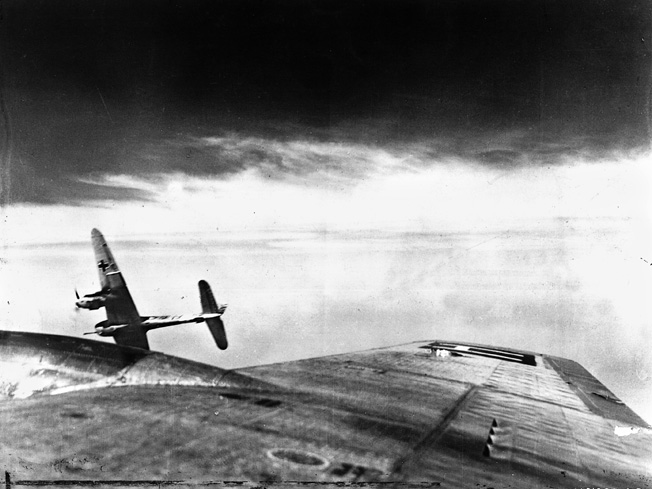
The solution, they determined, was to attack the bombers head-on. When the bomber was hit from the front, there was nothing to stop the bullets and shells. Four or five 20mm hits were often enough to knock the plane out of the sky. Moreover, the bombers had fewer guns capable of firing forward. The high closing speed gave B-17 and B-24 gunners little chance to hit the small, rapidly moving target. The combined closing speed of nearly 500 mph allowed the German pilots time for only a half-second burst of fire, commencing at 500 yards. If it was accurate, though, it was deadly.
One bombardier recalled, “They came in from ten, twelve, two o’clock, guns winking, then, just a few feet away would break below, some of the hot-shots actually doing a roll as they went. You could feel the shells hitting the ship, but you were holding formation, and apart from a quick burst from the forward guns, there wasn’t a damn thing you could do about it.”
Striking Schweinfurt and Regensburg
The first series of American attacks deeper into Germany and the occupied countries began in late July 1943. Brig. Gen. Frederick L. Anderson, Jr., was given command of the Eighth Bomber Command, serving under the Eighth Air Force’s CG, Eaker.
Anderson unleashed “Blitz Week”—a series of raids during the period of July 24-30, 1943. While Blitz Week produced mixed results, the fact remained that 88 B-17s were shot down and many more were damaged beyond repair. German industry’s fighter output in July, meanwhile, exceeded 1,200 planes. Although the Blitz Week losses clearly demonstrated the B-17’s vulnerability without a powerful fighter escort, the Air Force felt something had to be done without delay to stop the Luftwaffe’s growth. What they tried led to disaster.
On August 17, 1943, Eighth Bomber Command staged Mission Number 84, its first deep-penetration strike into the German industrial heartland. The bombers would be totally unprotected over Germany as they attacked both the Messerschmitt factory at Regensburg and the ball-bearing production center at Schweinfurt, both cities located in Bavaria. A total of 376 bombers were dispatched; 146 of them were to strike Regensburg and the other 230 were to attack Schweinfurt.
Under the initial plan, the two raiding forces, flying southeast from their bases in England, were to merge and then make their initial penetration deep into Germany as one powerful force. Then, south of Frankfurt, which is 76 miles from Schweinfurt, the Schweinfurt strike force was to veer northeast to attack the ball-bearing factories. At the same time, the Regensburg force would continue southeast to hit the Messerschmitt factories, but then, instead of turning northwest to return to England as the Germans would expect, the force would swerve south over Austria and Italy and continue across the Mediterranean to North Africa. Once over North Africa, it would land at the American bases there.
The heart of the initial plan was for the Regensburg force to strike first. Flying just 15 minutes behind, the Schweinfurt force would then move in to attack the ball-bearing factories. As Schweinfurt and Regensburg are only 109 miles apart, the time and the takeoff interval between the two forces was absolutely critical. The plan assumed the Regensburg strike force, by turning unexpectedly toward North Africa, would mislead the German fighter pilots.
During this critical period of hoped-for Luftwaffe confusion, and shortly thereafter, while the German fighters were on the ground refueling after wasting crucial fruitless moments searching for the Regensburg flight, the Schweinfurt raiders would attack the ball-bearing plants that should be, at least for a few moments, without air protection.
The all-important factor in making this plan succeed was the takeoff times of both the Schweinfurt and Regensburg air fleets—times that fell victim to Mother Nature. Because of bad weather, the Regensburg force was delayed by one-and-a-half hours before take-off and the Schweinfurt force was delayed five hours before going into the air.
These changes in takeoff times totally destroyed any chance for surprise and, worse yet, created two separate and unrelated bombing raids instead of a single, powerful, critically timed attack.
Disaster Over Germany
In allowing what was, in essence, two separate missions to proceed, Anderson presented the Luftwaffe with an abundance of time to get ready and attack each force separately, something they did as soon as the short-range P-47 Thunderbolt fighter escorts turned back at the German border. Ferocious and bloody air battles ensued.
The German fighters attacked en masse, hitting the bomber formations head-on, exploiting the known weakness in the B-17s’ nose armament. The B-17Es and B-17Fs were equipped with one .30-caliber nose gun and two .30-caliber cheek guns, manned by the navigator and bombardier—hardly the most skilled gunners. Lieutenant Edwin Frost, who was in the nose of a B-17 and firing a cheek gun, recalled: “It was just pandemonium. It seemed that every gun was firing at once and the noise was terrific…. Most [German fighters] were coming straight through, tearing right through us….”
In addition to the moments of terror brought about German fighters slashing through the bomber formations, and the black puffs of deadly flak exploding all around, the surviving crewmembers remembered the numbing cold at high altitudes and the frightening sight of their fellow bombers being shot out of the sky in great numbers.
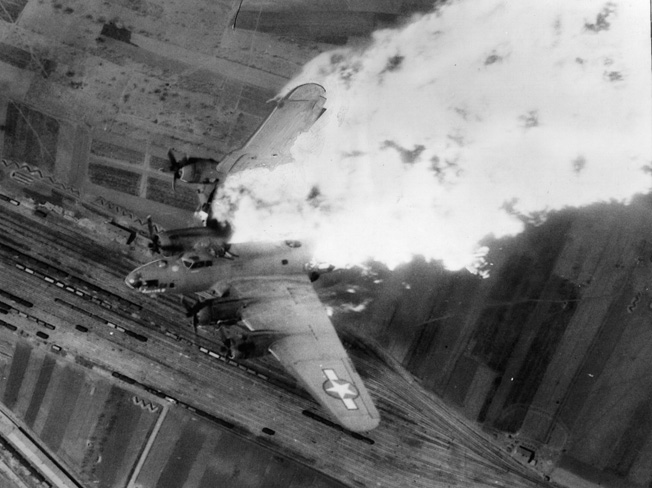
Lieutenant Colonel Beirne Lay, Jr., one of Eaker’s staff officers, flew as an observer on the Regensburg raid. In his November 6, 1943, article in The Saturday Evening Post, “I Saw Regensburg Destroyed,” he described the carnage: “On we flew through the cluttered wake of a desperate air battle, where disintegrating air craft were commonplace and the white dots of sixty parachutes in the air at one time were hardly worth a second look. The spectacle on my eyes became so fantastic that my brain turned numb to the actuality of the death and destruction all around us. Had it not been for the squeezing in my stomach, which was trying to purge, I might have easily been watching an animated cartoon in a movie theater.”
John Comer, a flight engineer serving in the top turret of a 381st Bomb Group B-17, reported, “At times it looked like the entire Luftwaffe was lined up at twelve o’clock high.” A navigator in the Schweinfurt wave, looking down, wondered why so many haystacks were burning. He discovered they were not haystacks; they were the wrecks of flaming B-17s.
Elmer Bendiner, a navigator fortunate enough to have survived the raid on Schweinfurt, recalled what he thought and felt when he came back. Bendiner, later awarded the Distinguished Flying Cross, the Air Medal with three clusters, and a Purple Heart, poured his memories into his 1980 book, The Fall of Fortresses:
“We had been in the air for eight hours and forty minutes. We had been in incessant combat for close to six hours. It had been fourteen hours since we had risen in the predawn. In that time sixty B-17s had been shot down, six hundred men were missing. The first major strategic air battle of the war had been fought. Did we win? Did we lose? Did we really see those planes burning on the ground? Did we see this one fall and that one fart black smoke from his engine? Whose chute opened? Whose did not? Questions turned in the hollow mind bereft of thought, like an awl in wormwood, biting into nothingness, the nothingness of spent men at last asleep.”
The American losses were devastating; 60 bombers were lost, 36 from the Schweinfurt flight and 24 from the Regensburg flight. In addition, 87 bombers were damaged beyond repair, or were forced to be left behind in North Africa because of inadequate repair facilities. This led to a total loss to the Eighth Air Force of 147 B-17s.
While many of the B-17s left behind in North Africa were eventually repaired and assigned to the Africa-based Twelfth Air Force, the fact remained that of the 376 B-17s dispatched on this raid, the loss of 147 bombers amounted to a staggering 39 percent of the dispatched force.
The air generals struggled to put a good face on the raid with claims of success, but they could not hide the fact that the losses made it impossible for Anderson to mount an immediate follow-up raid. A second raid soon after the first raid might have crippled Luftwaffe production, something the first raid did not do. There would be a second raid on Schweinfurt within two months, but then, as with the first raid, the results would prove insignificant. However, this fact would only become known when the war was over.
Emerson reports,“After the war, German experts estimated that even if the bearings industry had been wholly destroyed─… it could have been rebuilt absolutely from scratch in about four months time…. [But] … on the basis of available allied intelligence in 1943, Schweinfurt appeared to be a target of the first importance.”
“Black Thursday”
After the Schweinfurt-Regensburg raids, there were fewer long-range bomber attacks into Germany as the Eighth Bomber Command licked its wounds and replaced its losses. It did not resume the heavy bombing of Germany until September 6 with Mission Number 91, when 338 bombers were dispatched to attack Stuttgart.
The Luftwaffe again fought viciously and, as the bombers’ primary targets were clouded over by bad weather, the Fortresses attacked “targets of opportunity” on their way home. Two hundred and sixty-two of the dispatched bombers reached their targets, but 45 of them were shot down.
Losses continued to mount as 106 bombers were knocked out of the sky during the first 10 days of October. One reason for the heavy losses was the Luftwaffe’s 20mm cannon.
Perret reports that Lieutenant Paul Perceful, a copilot with the 95th Bomb Group, saw a B-17 “cut in two by the concentrated cannon fire of a German fighter.… It appeared to happen in slow motion. The Fortress was struck and slowly came apart at the radio room. From the front half of the fuselage, wings, still functioning engines and the cockpit, seemed to slowly rise upwards, completely separate from the rear fuselage and tail unit. Then both halves twisted and tumbled down and away.…”
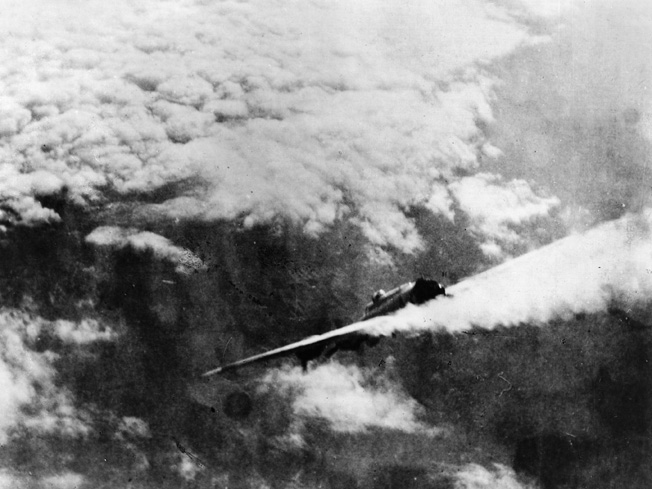
On Thursday, October 14, 1943, with Mission Number 115, the still-unescorted and vulnerable B-17s were again ordered to attack the German ball-bearing factories at Schweinfurt. Two hundred and ninety-one bombers were dispatched, with about 2,910 airmen. Initially, the bombers were to be protected by twin-engine Lockheed P-38 Lightning fighters equipped with drop tanks. However, the P-38s were not ready in time and once again the bombers were on their own.
The crews learned about their destination with deep gloom. There were boos and groans from the officers when the mission was announced. Perret reported, “The flight engineers and gunners waiting outside listened with dismay.” At one briefing, the commanding officer of the 385th Bomb Group, Colonel Elliot Vandevanter, concluded a pep-talk with, “It’s a tough job, but I know you can do it. Good luck, good hunting and good bombing.” At this, someone in the rear of the briefing hut added, “And good-bye.”
Not surprisingly, the raid was a disaster. The Luftwaffe was ready and attacked the 291 B-17s at points just south of Aachen when lack of fuel forced the bombers’ “Little Friends” to turn for home. Hundreds of German planes of various types swarmed into the bombers’ formations on their way to and from their target.
Of the 291 bombers dispatched, 257 were able to penetrate into German airspace, and, of these, 229 bombers managed to reach Schweinfurt and drop their bombs. Sixty were shot down—slightly less than 21 percent of the total force. Thus, 197 of the 257 bombers that had penetrated German airspace managed to return to England. Of these, five crashed on landing while 17 more managed to land but were damaged beyond repair. The total number of B-17s lost was therefore 82 (60+5+17) of the 291 dispatched bombers.
In addition, 142 of the remaining 175 planes (197-5-17) that had returned to England were damaged. Therefore, a mere 33 of the 291 dispatched bombers returned unscathed—a little more than 11 percent of the force. Five complete air crews were reported killed in action, 10 were seriously wounded, and 33 lightly wounded; 594 men were missing in action, many of them dead. In total, there were 642 casualties—22 percent of the 2,910 men who took to the air.
The Air Force called October 14th “Black Thursday,” and for good reason. It signaled the end of unescorted daylight precision bombing, although some air generals refused to accept this.
“The Care and Accuracy of a Marksman Firing a Rifle”
Even after Black Thursday’s horrific loses, General Arnold, evidently still a strong supporter of unescorted daylight precision bombing, said during an interview shortly after the raid: “We did it in daylight with precision, aiming our explosives with the care and accuracy of a marksman firing a rifle.”
Whether Arnold believed what he told the newspaper, magazine, and radio reporters, his words were simply not true. Mark Arnold-Forster in his 1973 book, The World at War, succinctly explained: “When the war began, both the British and Americans were convinced that their bombing would be accurate. In fact, it never was. The Americans devoutly believed in the efficiency of their Norden bombsight, which, they contended, enabled them to hit a ‘pickle barrel’ from a vast height in daylight. But … as long as the defenses were strong, the bombers were unable to bomb with accuracy because they could not fly straight and level for long enough to take aim.”
The loss percentages were grim for the entire month of October 1943. William Emerson reports: “214 heavy bombers had been lost … almost 10% of the number dispatched. The damage rate was 42% for both major and minor damage. Losses and damages added together totaled to more than half of the credit sorties flown during the month. At this rate, an entirely new bomber force would have to be created almost every three months in order to sustain the level of the current bomber offensive.”
It was obvious that the Air Force could not do this, and it was equally certain that the bomber generals’ belief in unescorted daylight precision bombing—a belief to which they had been faithfully dedicated for virtually their entire military careers—was a complete disaster, a military dogma destroyed by the burning B-17s over Schweinfurt on Black Thursday.
Indeed, unescorted daylight precision bombing died hard. On October 22, eight days after Black Thursday, General Anderson, at a meeting of the Eighth Bomber Command wing and group commanders, canceled the daylight heavy bomber offensive against Germany. “We can afford to come up,” he said, “only when we have our fighters with us.” One of the bomber crewmen had been more blunt at his post-raid debriefing: “‘Any comments?’ the debriefing officer asked. ‘Yeah,’ the crewman replied. ‘Jesus Christ, give us fighters for escort!’”
The fighters eventually came. But, in the meantime, deep penetration raids into Germany were suspended until February 1944.
The North American P-51 Mustang and the Death of the Luftwaffe
It was a tragic irony that a long-range escort fighter had been readily available for about two years. The plane was the North American P-51 Mustang, a fighter first flown in October 1940 but seriously underpowered at altitudes above 15,000 feet. However, the plane “grew mighty indeed” when it became the P-51B after its American Allison engine was replaced by the Packard supercharged version of the British Rolls Royce Merlin engine in late 1942. Both the P-51B and P-51C went into production at the same time; the only real difference between the two models was that the “B” was manufactured in Inglewood, California, while the “C” was built in Dallas, Texas.
The first P-51B/C fighters entered service in England in December 1943, but relatively few planes were involved. The P-51D was a different story. It was a significant upgrade from the P-51B/C. It possessed a combat range of 950 miles and, with drop tanks, an operational range of 1,300 miles. It was capable of a top speed of 437 miles per hour and carried six, rather than four, .50 caliber machine guns.
The reprieve that the German heartland had enjoyed from American daylight bombing ended in February 1944 as hundreds of P-51Ds began arriving in England. These new “Little Friends” began to race across the German skies protecting their “Big Friends,” the “heavies.”
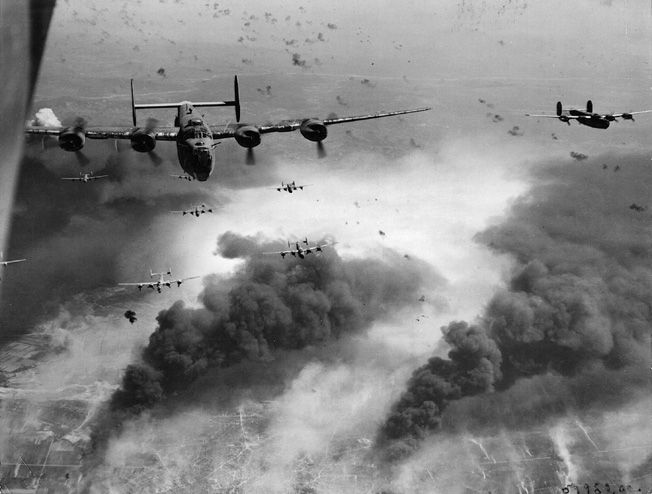
When reports of the first dogfights over Germany reached Nazi Air Minister Hermann Göring, he refused to believe them. He knew of no Allied fighter that had the range to reach so far into Germany. However, when he was finally convinced the dogfights did indeed take place, he was reported to have muttered, “We have lost the war.”
While Göring was right, the Mustang did not win the air war over Germany on its own. All operating P-47 Thunderbolts and the Lockheed P-38 Lightnings, which had returned to England in force by September 1943, had their ranges extended through the addition of new external tanks. These planes, too, played a significant role in the death of the Luftwaffe.
The End of Unescorted Daylight Precision Bombing
What unescorted daylight precision bombing accomplished can only be judged in retrospect. Sir Charles Webster and Noble Frankland, writing in The Strategic Air Offensive Against Germany, noted, “The achievement [and] the subsequent attack on the aircraft industry was to reduce not the production of aircraft but the fighting capacity of the Luftwaffe. The attack on the aircraft industry was, in fact, another example of the failure of selective bombing. This combat was provoked by the American heavy bombers which carried the threat of the bomb to the heart of Germany by reaching out to targets of deep penetration and leaving the German fighters with no alternative other than to defend them. But the combat was primarily fought and certainly won by long-range fighters of VIII Fighter Command….”
This was certainly not what the American “bomber generals” envisioned would happen. The failure in their unescorted daylight precision-bombing planning was in rejecting any potential need for long-range escort fighters and, instead, concentrating all their efforts on “invincible” heavy bombers.
The “success” of unescorted daylight precision bombing came about when, unexpectedly, the “heavies” so desperately needed the protection of long-range escort fighters, which in the end led to the Mustang. The resulting dogfights between the American and German fighters and the Luftwaffe’s hemorrhaging losses as it was sucked into the meat grinder of air battle after air battle against a constantly growing number of American escort fighters became a primal factor in the Luftwaffe’s destruction—a destruction, which in turn, allowed D-Day to proceed and succeed.
On D-Day, General Dwight Eisenhower assured his troops that, “If you see fighter aircraft over you, they will be ours.” He was right, and both unescorted daylight precision bombing and the Luftwaffe moved into the pages of history.
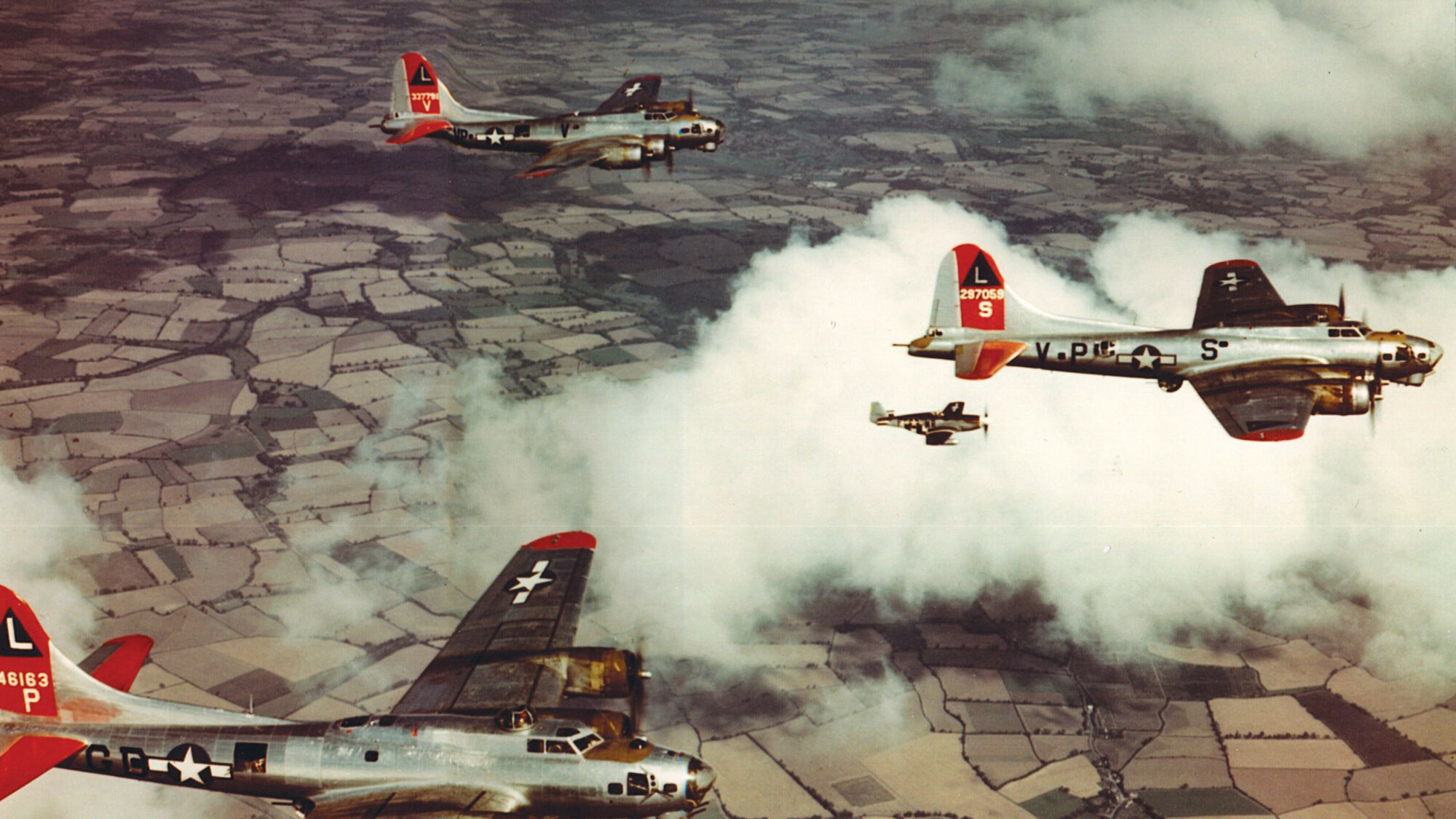
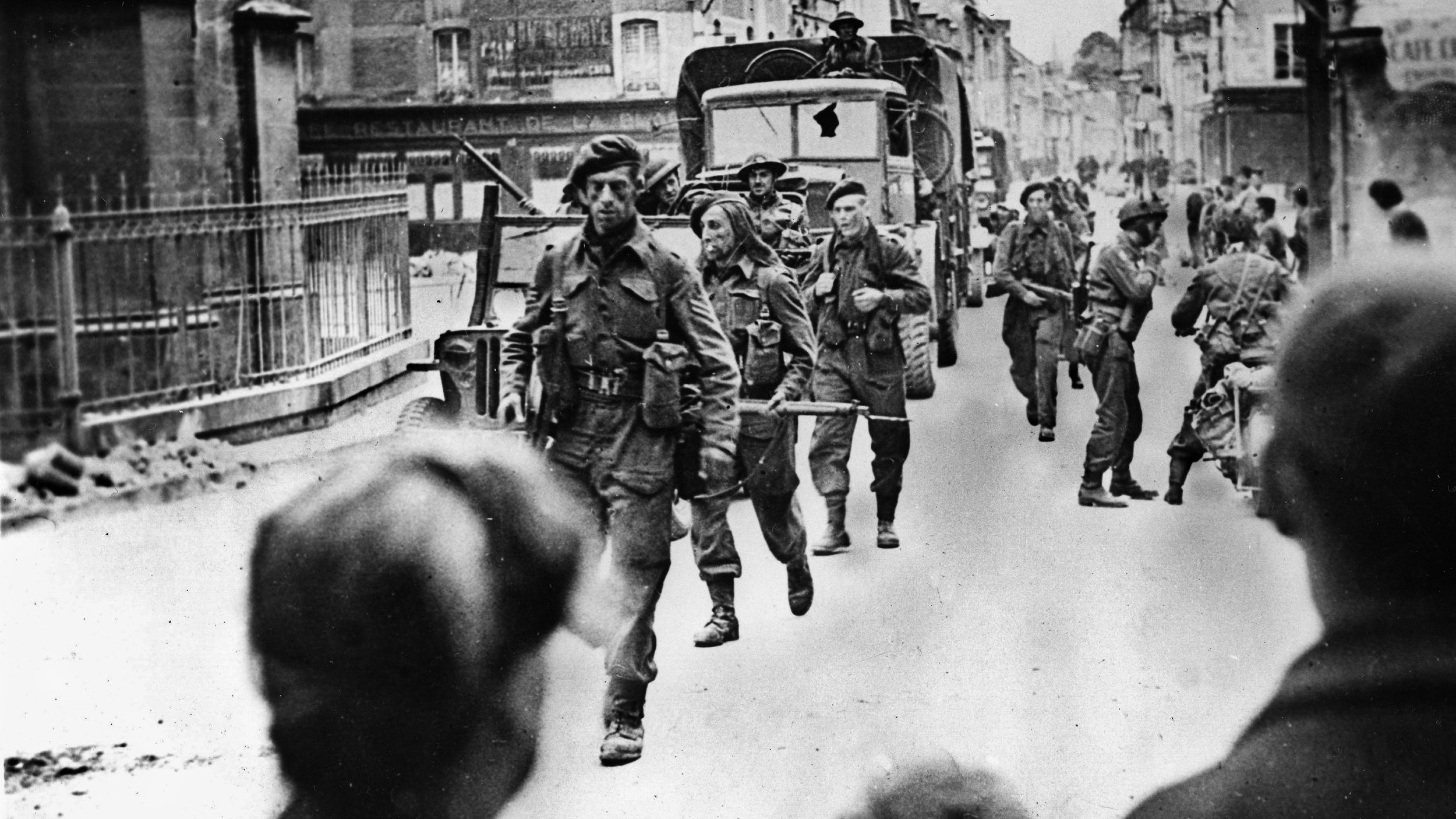
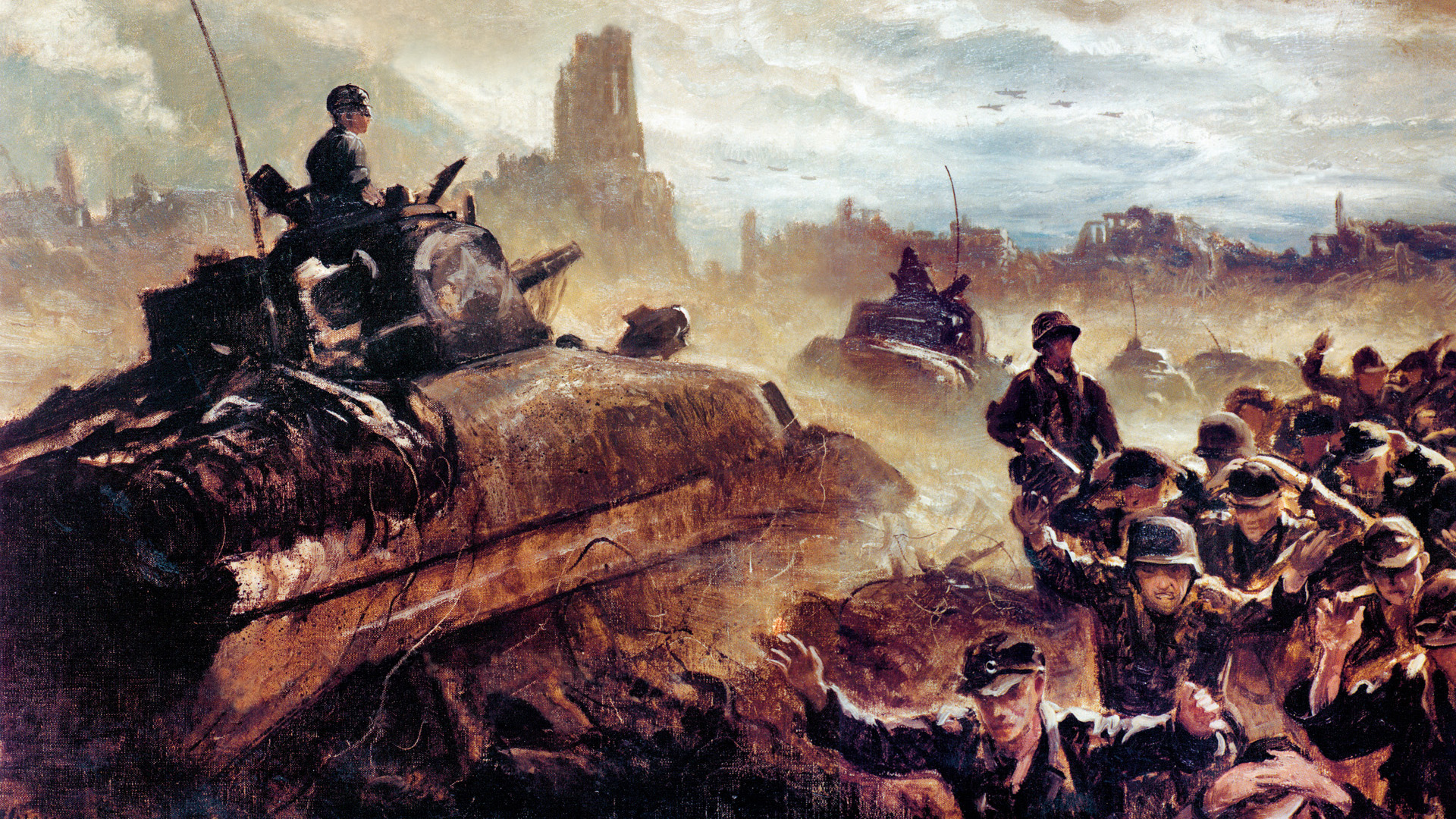
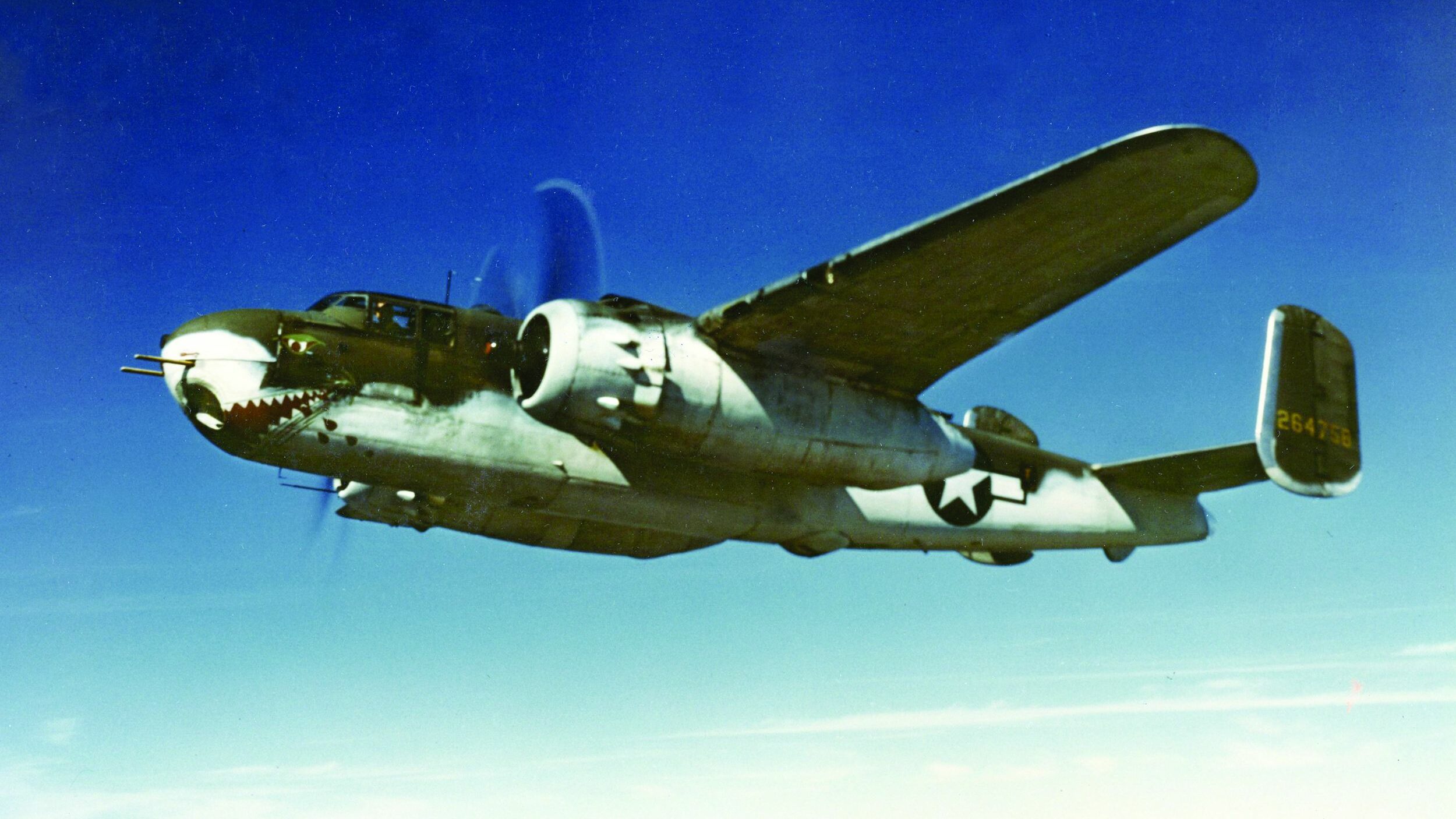
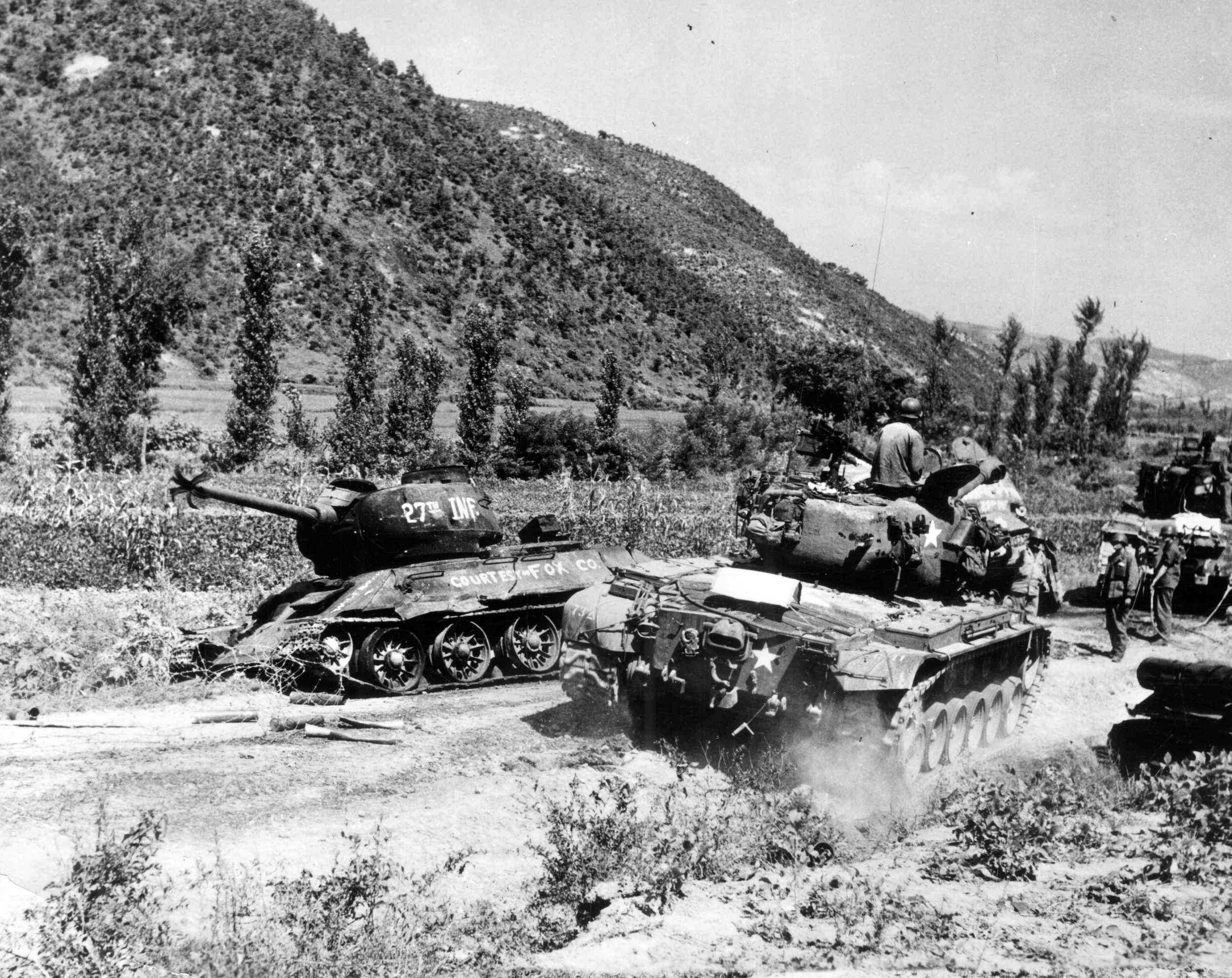
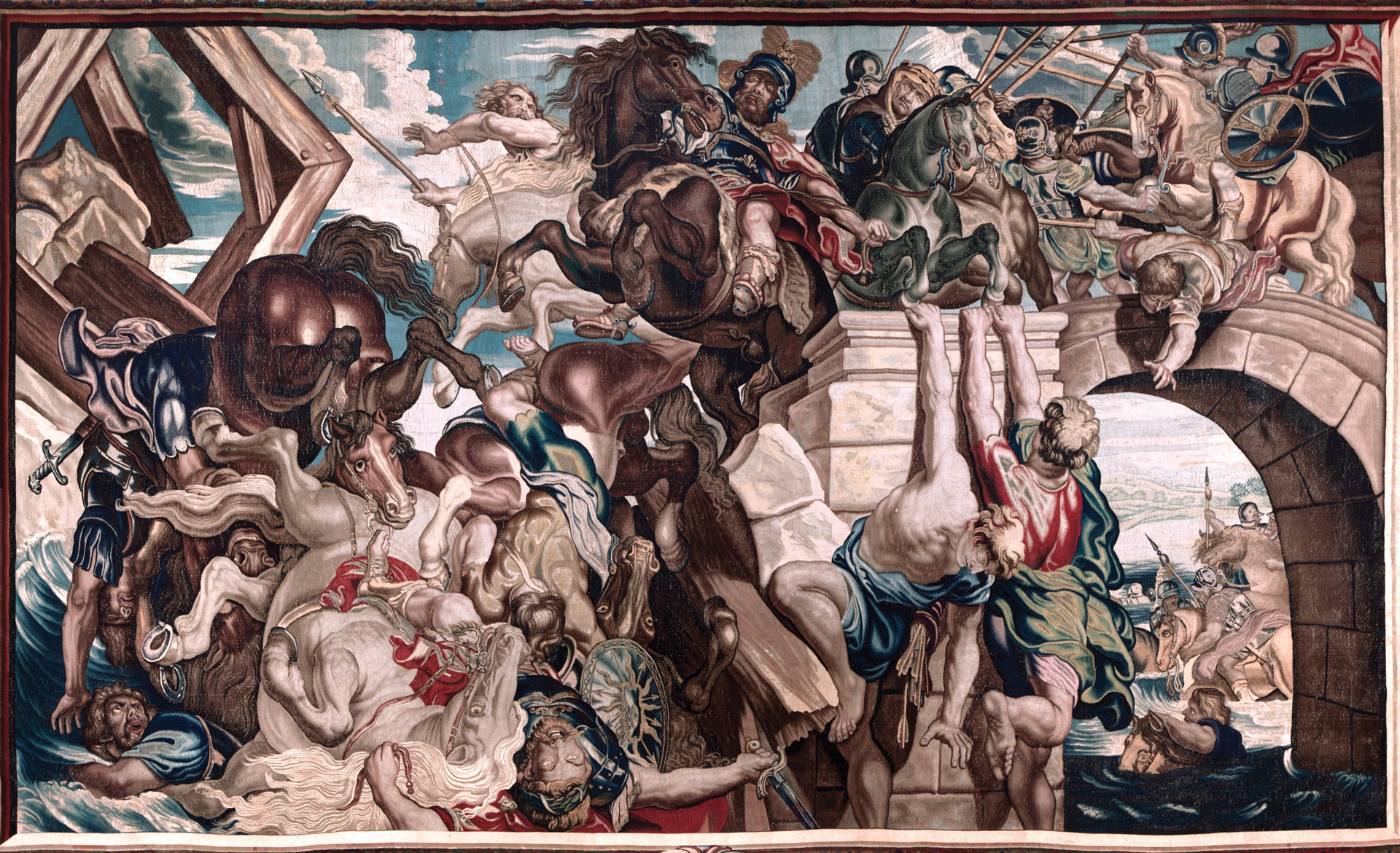
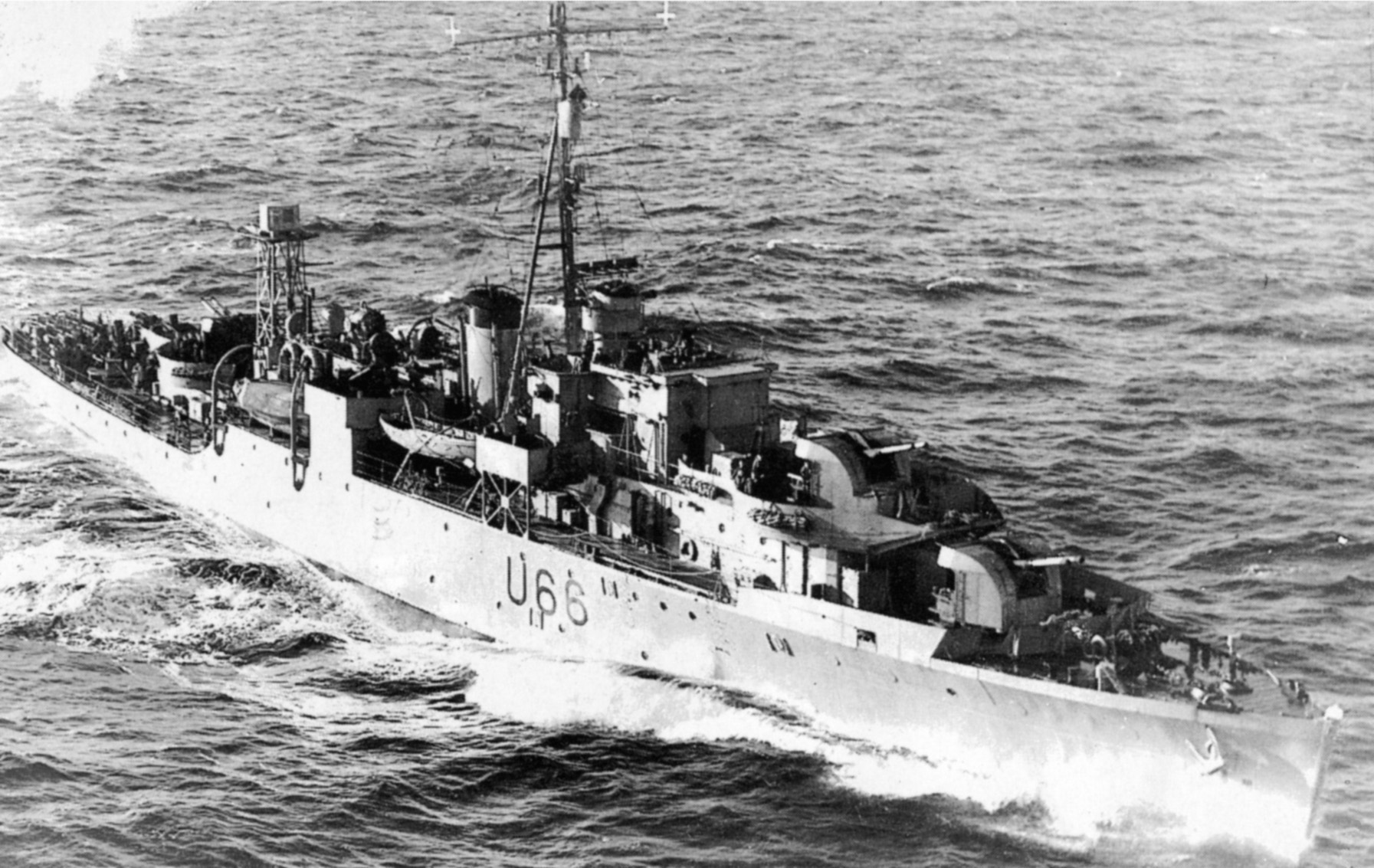
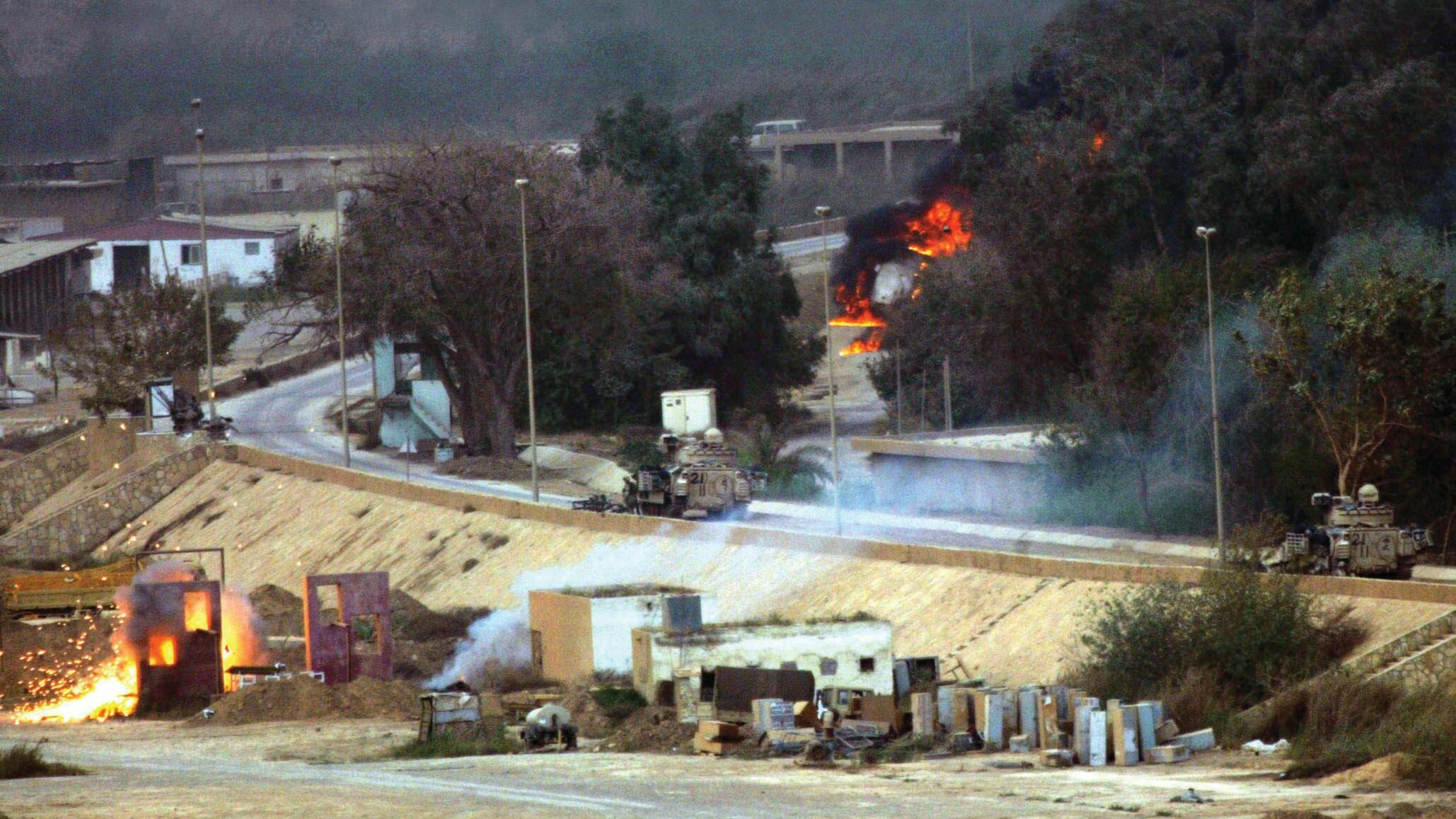
The German plane identified as a BF110 appears to be a BF210 or 410, with a 50mm cannon.
Correction, should have read: “Me210 or Me410”.
Very interesting how incompetence can be protected and rewarded.
There’s a big difference between “unescorted” and “precision.” As a matter of fact, the early missions were escorted as far as the fighters could go. As for the Navy, they had their own Liberators and dropped bombs with precision. They used dive-bombers because they could operate off of carriers. The picture of the German fighter is one my dad had. It’s not banking “to avoid a collision,” its banking after a firing pass.
I should have mentioned that it wasn’t the P-51 that allowed daylight bombing, it was the P-38 and P-47. VIII Fighter Command came up with new drop tanks to increase the range of the P-47 and P-38s were already capable of going all the way to Berlin, although they had problems initially that kept them from being used, not to mention that they were being sent to the Mediterranean. P-51s actually didn’t start appearing in large numbers until mid-1944 AFTER Eighth AF resumed deep penetration raids escorted by P-38s and P-47s. VIII FC also initiated new tactics of attacking the assembling Luftwaffe fighters rather than trying to keep them away from the bombers. They also sent the fighters to the areas where attacks were most likely to occur, with P-47s patrolling at the limit of their range while P-38s went to the targets. Also, the first P-51s were assigned to Ninth Air Force, not Eighth. They were originally planned to be used tactically but they were so vulnerable to ground fire that they were given to VIII FC. Chuck Yeager said P-51s were so vulnerable that “a kid with a slingshot could knock one down.” Like the Spitfire, they had glycol cooling systems that were especially vulnerable. A hole in the glycol lines would cause the coolant to leak out and the engine would seize. My dad flew thirty missions in B-24s from Big Week in February 1944 to just before D-Day and he said he never saw a P-51. Their escorts were mostly P-47s.
My uncle was lost on a raid over Germany in September of 1943. 192 bomb group, his B-17 became a straggler and crashed in a newly freed part of Belgium. Two of the crew of nine survived. They were set upon by German fighters upon their return and received an allied fighter escort at the border but were unable to return to England.
To persist in these tactics in 1943 was a near criminal enterprise. The only thing that could be said for continuing them was the lack of intelligence on the effectiveness of the bombing. The cost was quite apparent and greater efforts should have been made to address the casualty issues. Also, it should be noted that the Germans did not have a policy of relief after 30 missions, or any number for that matter. They flew until killed or disabled. By late summer 1944, the quality of the Luftwaffe and skill level of the pilots was greatly diminished.
In WWII bomber usage was still in the experimental stage as was radar and many forms of radio transmission. The jet stream was little understood and there was no box formation until Curtis LeMay created it. The RAF and the USAAF both had huge losses of bombers in the early years of the war as did the navy in both oceans. The invention of the hedgehog rocket solved the submarine problem in the Atlantic in the summer of ’43. The jet stream problem was not solved until ’45 when Curtis LeMay experimented with low altitude bombing missions beginning in March of that year. The key to turning the tide in the European air war was the combination of bomber escorts and ground attacks after the bombers left the target area. Those ground attacks destroyed airfields, aircraft, supplies of fuel and ammunition, supply trains leaving the aircraft factories and fuel storage areas. In short the Nazis had fewer and fewer fighters after each bombing mission. That allowed allied fighters to destroy tanks on the ground and is the reason there were no major tank battles on the Western front. The Pacific theater saw enormous losses from ’42 until the day of the surrender of Japan. Coral Sea and Midway were successes but at a cost of many Navy ships. Many marine and army battalions were annihilated in the island campaign. It was equivalent to several D-Day landings at Omaha and Utah. So the bombing campaign was no more deadly than any of the other meatgrinders in the war and proved to be just as successful in its attrition of the enemies war making abilities.